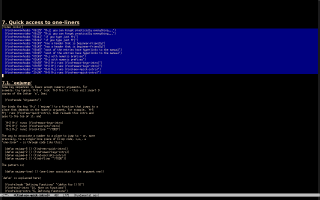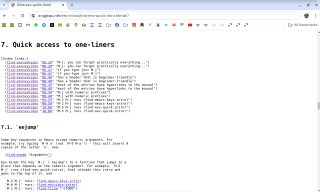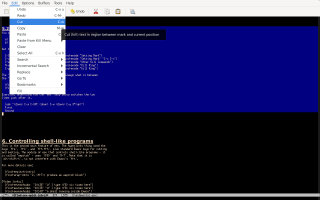Learn this after cut and paste: create your first executable notes (2024)
(This is part of: 2024-restructuring)0. Prerequisites
This page was written for people who have just installed eev by following the instructions in the video about "installation and navigation", and who don't know anything else about Emacs or eev.
1. Introduction
Eev is made for people with bad memory: you can forget everything except for the three main keys -
and typing `M-j' will take you to a buffer whose header will remind you, or teach you, all the rest. That buffer looks like this:
Note that I've highlighted - or "marked" - the three lines of the header that explain key sequences that go to the ~/TODO file. This page will be partly about them.
I will use an abbreviation here, and I will write, for example,`M-123j' instead of `M-1 M-2 M-3 M-j'. `M-123j' is pronounced "meta-onetwothreejay", and it means "hold down the meta key, type 123j, release the meta key".
2. Learning `M-j'
`M-j' is explained in Section 7 of the main tutorial, and note that that section starts with hyperlinks to a video:
Those hyperlinks will only work inside Emacs - with `M-e' - if you have done certain configurations, but they work out of the box in the htmlized version of the tutorial. Try it by following the link at the end of the next line:
(find-eev-quick-intro "7. Quick access to one-liners") |
The best way to understand what `M-j' does is to watch the video in these links from 06:29 to 10:09.
3. Cut and paste
I'm experimenting with new ways to teach eev to total beginners. If you are a total beginner but you have managed to install eev, try this: first make sure that you understand what each one of the links in the blue region below does,
then open each one of the links below - more precisely: the link at the end of each line - in a different browser tab,
(find-eev-quick-intro "5.2. Cutting and pasting") (find-emacs-keys-intro "3. Cutting & pasting") (find-emacs-keys-intro "6. Windows") (find-windows-beginner-intro "6. Learn the basics of Emacs and eev") |
and then:
- copy the contents of the section "6. Learn the basics of Emacs and eev" above from the browser to your ~/TODO file,
- save your ~/TODO file with C-x C-s.
Note that you don't need to remember the keys that Emacs uses for cut, copy and paste, or for saving files - you can use the tool bar or the menu bar, as shown below:
(Announcements: eev mailing list)




